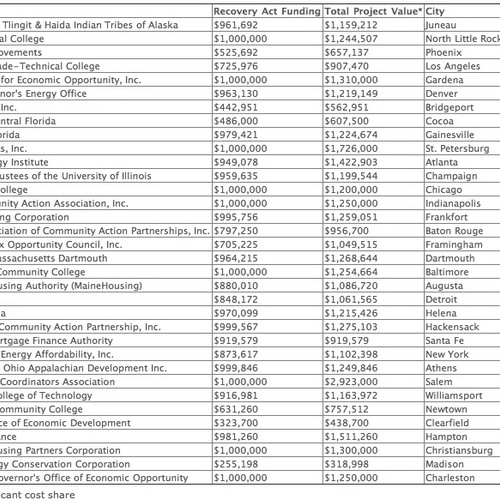Image Credit: Department of Energy (first chart) and Government Accountability Office (second chart)
Image Credit: Department of Energy (first chart) and Government Accountability Office (second chart) This chart lists factors state and local government officials most often cited as affecting their ability to select or start projects. The GAO notes, however, that because some state and local agencies also listed other factors, the chart is not comprehensive.
It may well be that someday a lot of people will be hired by state and local agencies to weatherize homes – and actually do the work – on the grand scale envisioned when the American Recovery and Reinvestment Act was signed into law, a year ago this month. But by the end of December, some 10 months after the stimulus bill was enacted, most aspiring cast members of The Greatest Weatherization Show on Earth were still waiting for callbacks.
Over the past few months, a flurry of news reports – some of which we’ve recapped on GBA – have highlighted states’ struggles to expand their programs, manage huge funding increases delivered by the stimulus bill, and sort through accompanying federal regulations, such as the imposition of the Davis-Bacon Act’s prevailing-wage requirement. Federal officials are now echoing the concerns raised in the news stories.
A GAO preview
Earlier this month the Government Accountability Office released a report titled “Project Selection and Starts Are Influenced by Certain Federal Requirements and Other Factors” (a 34-page pdf), based on data collected in 16 states. The report cites three principal reasons that stimulus-funded programs have been slow to launch: the Davis-Bacon requirements; buy-American provisions (which mostly affected projects of the Departments of Commerce, Education, Homeland Security, and Housing and Urban Development, and the Environmental Protection Agency) and the National Historic Preservation Act (affecting mainly programs of the Departments of Commerce and Transportation).
Last Friday, the DOE’s inspector general, Gregory Friedman, issued a report that’s in line with the GAO findings but more explicit about the problems afflicting the Weatherization Assistance Program. Friedman’s report blames sluggish program rollouts on confusion over Davis-Bacon requirements but also on such things as recession-fueled hiring freezes and furloughs at some of the agencies managing weatherization programs, even though stimulus funds would have paid the additional salaries. (It’s an irony not lost on many bureaucrats.)
A recent New York Times story, for example, noted that a hiring freeze in New York City helped delay the rollout of weatherization programs throughout the state, whose goal is to weatherize 45,400 housing units over three years. By the end of December, however, the state had a completion rate of only 0.62%, or 280 units. The DOE visited sites in 32 states and found similarly dismal completion results in many of them, including Texas (with a 0% completion rate on its three-year target of 33,908 units), California (0.03%), North Carolina (0.89%), and Michigan (1.15%).
Diagnosis and treatment
Friedman called the overall results alarming, particularly for a program that, a year ago, was deemed “shovel ready,” and whose administrative infrastructure has been in place for decades. But the DOE report affirms what we know already about government programs that get really big: they can do plenty of good, but they struggle mightily with synchronization and implementation. What’s more, the political pressures accompanying stimulus-funded program expansions have prompted most administrators to move cautiously, and pay special attention to training and auditing procedures designed to prevent and detect fraud.
The DOE says it is taking steps to accelerate WAP work, in part by simplifying National Historic Preservation compliance rules for weatherizers and program-eligibility criteria for multifamily dwellings. Each state must complete work on at least 30% of the housing units it plans to weatherize during the three-year period before it can draw down on the remaining 50% of its stimulus-fund allotment. The delays so far have put pressure on a DOE outreach initiative, “Operation Green Light,” that dispatched senior department officials to nine of the highest risk states to help move things along.
With everyone scrambling to right the weatherization ship, it could be that the worst – the confusion and delays pegged to expanding some state programs – is over, or nearly over. But if it’s not, the DOE may have to rethink its program goals.
Weekly Newsletter
Get building science and energy efficiency advice, plus special offers, in your inbox.















4 Comments
Weatherization is not glamorous
Some of us who have been in the energy efficiency trenches for many years had little hope the green economy would take off like a kite. Only the most glaring efficiency deficits for a building are cost effective, reducing infiltration and adding insulation where there was little or none previous.
Cheap energy and the lack of a meaningful carbon tax will ensure business as usual in the US, the threat of peak oil and catastrophic climate change seem not to matter.
Weatherization in MN was shovel ready until Davis Bacon
People in the US are too used to instant gratification. Let the programs in Minnesota have one more quarter and the numbers are going to show a hugh improvement. I manage a local wetherization program and we increased our crews from 4 to 8 (2 person crews) and are completing the hiring of 4 additional crews as I write this. This means 16 new jobs just on our crews. I had to hire staff to conduct audits and provide support for those crews. The Davis Bacon issues caused me to shift our production counts to our regular DOE program, and we were only able to start counting in December. We have maintained good numbers through Jan and Feb in weather that is not easy to work in. We have also stimulated our local and state economies by purchasing vans, equipping them with specialized tools and purchasing various insulation materials and weatherstripping products. All we ask is for everyone to stand back and watch us do our job of reducing our dependence on foreign oil.
Thanks, Richard
Richard,
Thanks for providing news from the front lines. I know from experience that weatherization crews are doing important work, and doing it well. Keep up the good work.
weatherization
Let us not forget the anti-stimulus affect of the stimulus program. Other than WAP programs, all of my other potential work is too often in limbo because people are anticipating stimulus benefits (such as the Homestar program) that might be many months away from getting implemented. So they don't want to do it now.
Log in or create an account to post a comment.
Sign up Log in